Car Engine Leaking Oil
Oil Leak
Car Engine Oil Leak Repairs
Helpful Information
There are two states of oil, pressurized and non-pressurized, leaks that are non-pressurized tend to be less aggressive while pressurized leaks can be excessive. If an oil leak is not obvious, clean the engine with a strong detergent before further inspection to make detection more accurate. Always clean an engine cold to avoid steam which can cause problems inside electrical connectors. Use a flash light to pin point the source of the leak, then formulate a plan to repair it which can vary greatly in effort, it's best to get a second opinion if a major repair is imamate. When inspecting for leaks start at the top of the engine and work down as oil can travel a distance before collecting into a drip.
History
Older engine's are equipped with a distributor drive port which is sealed with an O ring that when it fails can allow a leak.
Step by step guide on how to troubleshoot and repair an automotive engine oil leak, this information pertains to most vehicles.
Difficulty Scale: 5 of 10
Start with the car on level ground, engine "OFF" in park with the emergency brake on.
Step 1 - Engine oils are added through an oil port located near the top of the engine or on a valve cover. If this cap becomes loose, seal broken-failed or has failed to be reinstalled correctly after adding oil, it will cause a leak.
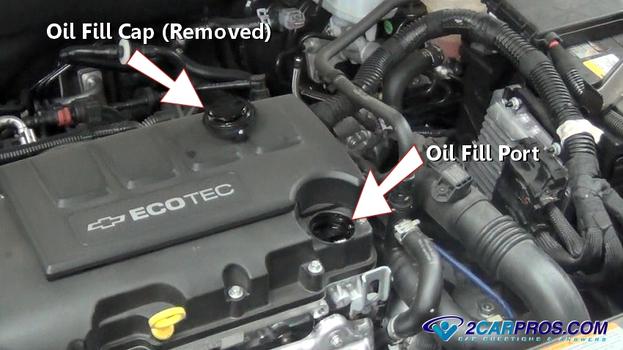
Oil Fill Cap Removed
Step 2 - The oil filter is used to remove carbon and other impurities created by the combustion process. This filter is subject to oil pressure supplied by the pump, and will leak if:
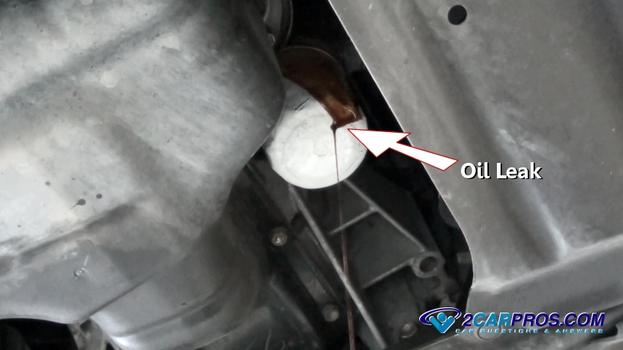
Oil Filter Leak
Step 3 - A drain plug is used to remove oil from the engine, this threaded plug uses a sealing washer which tightens flush against the oil pan. If the drain plug is loose or the sealing washer is missing or worn it can cause an oil leak. If a leak is detected use a wrench clockwise to check the tightness of the plug, if the plug is tight but still leaking the sealing washer needs replacement. If the drain plug is loose and will not tighten, the threads on the drain plug or inside the pan have failed and must be replaced or repaired.
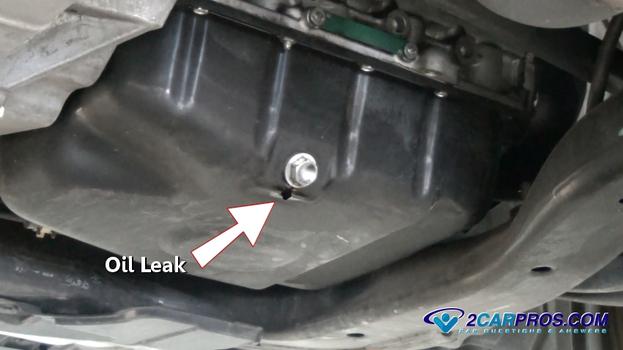
Oil Drain Plug Leak
Step 4 - The oil pressure sender is used to send feedback data to the PCM (powertrain control module) and oil pressure gauge or light in the instrument cluster. This sensor is subject to oil pressure much like the oil filter and when failure occurs can leak, this sensor is typically located near the oil filter.
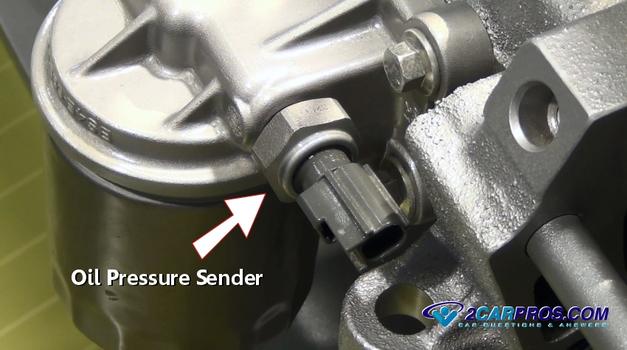
Oil Pressure Sender - Unplugged
Step 5 - Valve covers are used to encapsulate the valvetrain and control oil leakage. This cover is used in conjunction with a gasket which is located between the cover and the cylinder head. When this gasket ages, it can become brittle and crack allowing oil to leak. In other cases the valve cover can work itself loose which also can cause the aforementioned leak.

Valve Cover Gasket Removed
Step 6 - An engine is designed with a number of shaft seals (front-rear main and camshaft), a timing belt style of engine has more shaft seals which include cam and balance shaft seals. These seals are designed to ride against a smooth turning shaft while controlling the oil that surrounds it. Heat and usage can cause these seals to become brittle and leak. Depending on the location of the seal, replacement procedures could vary from removing the transmission, to disassembly of theengine front.

Front Main Seal - Balancer Removed
Step 7 - Timing chain style engines are designed with a cover that seals to the engine block front using a gasket which controls oil, this gasket can fail due to heat and usage and must be replaced to fix the leak.
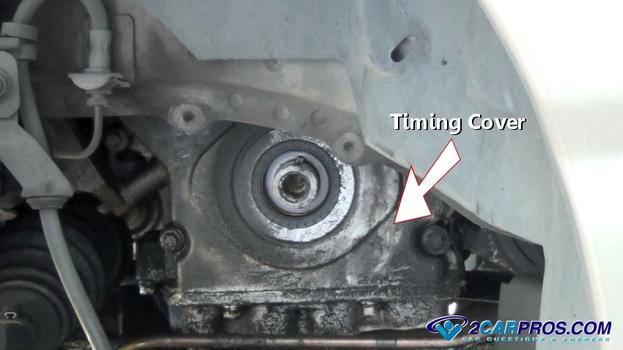
Timing Cover
Step 8 - Some engines are designed with an engine oil cooler-adapter that seals to the block with a gasket or "O" ring seal, heat can cause these seals or adapter-cooler to fail and leak.
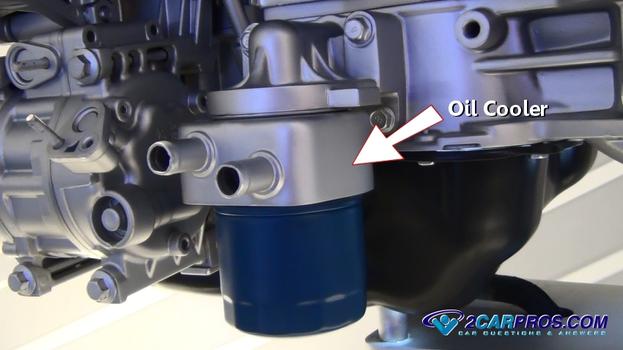
Oil Cooler Adapter
Step 9 - A oil level sensor is used to provide feedback data for the PCM which illuminates a warning light to alert the driver of the oil level, when this sensor fails it can leak allowing oil to exit the engine.
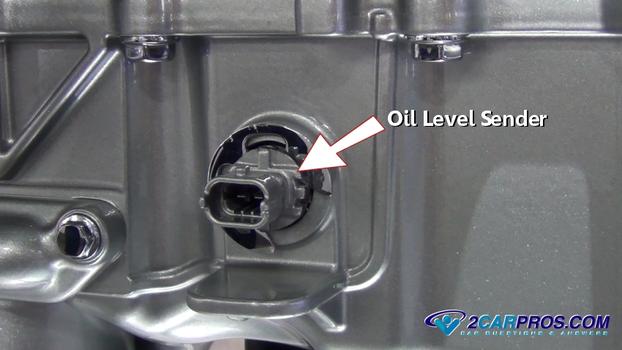
Oil Level Sender - Unplugged
Step 10 - An oil pan is used to collect oil into a centralized area allowing the oil pump to re-circulate it back into the engine. This pan is bolted to the bottom of the engine and uses a gasket to seal it to the block, if the oil pan gasket fails it can cause an oil leak and must be replaced.

Oil Pan
Step 11 - This step is for some "V" ( v6, v8 etc.) style engines only, The intake manifold is mounted to the cylinder heads with a seal or gasket between the engine block located at the front and rear of the manifold. Over time theses seals can age, causing them to deteriorate and leak motor oil. Unfortunately there is no easy fix for this condition, the intake manifold must be removed and the seals replaced to repair this problem.
Step 12 - Overhead cam designed engine's have pressurized and non-pressurized oil ports in the engine block that supply and allow oil drain back. These ports connect to and from the cylinder head which is used to lubricate the camshaft and other valvetrain components. If the head gasket fails it can cause a leak from between the engine block and cylinder head, to repair this problem the head gasket must be replaced.
Step 13 - Some engines are equipped with an external engine oil cooler that can leak which should be inspected when checking for an oil leak.

Oil Fill Cap Removed
- The filter is not tight
- The oil filter seal has failed
- The seal from a pervious filter is still on the engine.

Oil Filter Leak

Oil Drain Plug Leak

Oil Pressure Sender - Unplugged

Valve Cover Gasket Removed

Front Main Seal - Balancer Removed

Timing Cover

Oil Cooler Adapter

Oil Level Sender - Unplugged

Oil Pan
Comments
Post a Comment